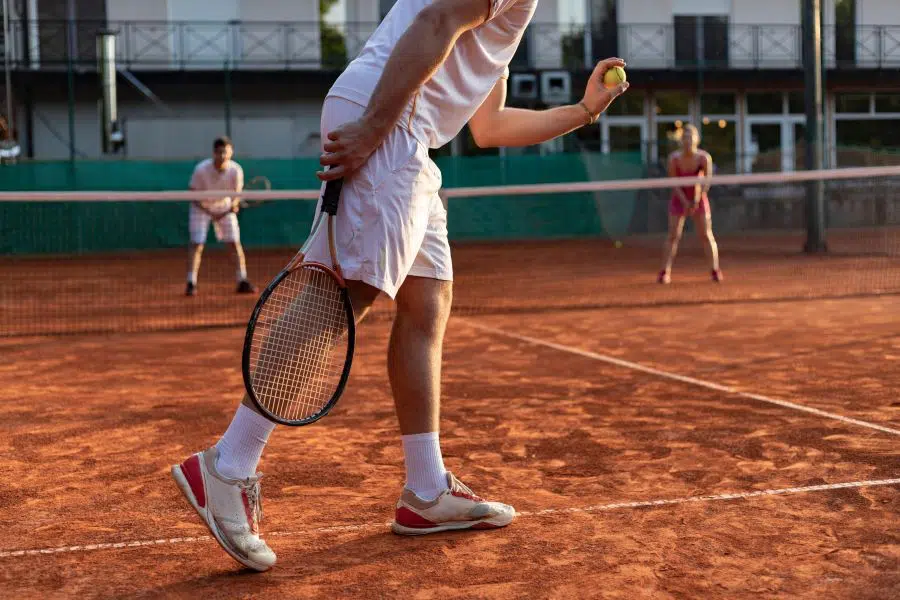Mastering the kick serve adds a serious weapon to your tennis game. The serve generates topspin to make the ball kick up off the surface, arriving around shoulder height to the receiver. A correctly struck kick serve will also have side spin to move the ball away from your opponent.
The kick serve is often used as a second serve because the arc on the serve results in less flirtation with both the net and the court lines. Most players will aim this serve out to an opponent’s backhand. The height of the bounce, combined with the ball swinging away, makes it harder for your opponent to control the return on their backhand side.
The grip is the key element to mastering the kick serve. How you hold the racket and how you position your fingers is a vital component in generating the spin needed for a successful kick serve. The correct grip brings control to your serve, and reduces the stress placed on your wrist and arm.
This article looks at the types of grip and the modifications you can make to your grip to help develop and improve your kick serve. I shall start with the two most common grips employed to deliver this effective serve.

1. The Continental Grip
This is one of the most commonly used grips for serving in tennis, and one of the first an instructor will teach.
It is a versatile grip which can be applied to different types of serves, including the kick serve.
This grip allows you to generate power without exerting too much stress through the arm.
The kick serve is your insurance serve. The arc generated should see the ball drop short of the court line, reducing the chances of a double fault when used on second serves.
The continental grip places your hand in the correct position to brush the ball and generate the topspin needed for a kick serve.
This grip allows you to continue to impart some power, providing an element of disguise to the serve. A right-handed continental grip is formed by placing the pad of the bottom knuckle of the index finger on the second bevel of your racket (source).
A v-shape is formed as you wrap the rest of your hand around the racket.
2. The Eastern Backhand
The attraction of the eastern backhand grip is in generating more spin on your kick serve.
Some players may use the continental grip for a powerful first serve, before switching to an eastern backhand grip for more spin on the second serve. When using this grip you accept a loss of power as a compromise for increased spin on the ball.
For this grip you slide your index finger back compared to the continental grip, placing it on bevel one for right-handers.
This slightly closes the face of the racket, helping to generate more spin. Some players will feel they have more control of their kick serve using this grip, while they can quickly switch back to a continental grip if desired when backing the serve up with a volley.
The eastern backhand grip offers a heavier spin on the ball. This additional spin can make it harder for your opponent to return and compensates for the reduced speed of the serve.
Without heavy spin on the ball, the slower serve would be far easier for your opponent to return and far easier for them to control their return, immediately putting you on the back foot in the rally.
3. Comfort
Whichever grip you are taught you will ultimately want a grip that is comfortable to use. For a kick serve you will want to feel in control of your grip and how the racket strikes the ball.
Through experience and practice, you will find which grip works best for you.
As you play and practice more you may even find a slight variation of the more common grips works best for you on a kick serve.
For example, you may find moving the index finger somewhere in between the standard continental and eastern backhand grips provides you more control. Working with a coach can help you find the most comfortable kick serve grip, one which also helps to reduce the stress on your wrist and arm.
4. Relax Your Grip
Many players, particularly when first learning, hold their racket too tightly.
This may seem right to begin with, as you feel you need to grip your racket hard to generate the power required for an effective serve.
However, instead, you should relax your grip as the tension in the arm and wrist is counter-productive to your swing.
By relaxing your grip you allow for greater flexibility. It is this flexibility that allows you to generate power while still retaining control of the racket head.
Any rigidity through the arm and wrist caused by a tight grip prevents a loosening of the racket and can see you struggle to generate power and spin on your kick serve.

5. Keep Your Fingers Apart
A good kick serve needs control, allowing you to impart pace and spin on the ball. You can gain more feel and control of your racket by slightly separating your fingers when holding your racket.
This is particularly so when using the continental grip.
Keeping the fingers apart can feel more comfortable, giving you more confidence in your kick serve grip. With comfort comes adherence, meaning you are more likely to persevere with the grip to try and master the serve.
6. Hand Heel Position
A solid grip is key to getting the technique right to hit a kick serve. Instinct again may see you hold the racket with the palm of your hand flush against the racket.
However, the further up the racket you place your hand the more limited the swing becomes.
For a kick serve you should position the hand so the fleshy heel pad is just below the base of the racket. However, your little finger should still be gripping the racket. By having a longer racket you have more leverage, providing more power and control to your kick serve.
7. Raise Your Index Finger
Whatever the serve or shot, tennis depends on feel and confidence in your grip. Raising your index finger so it points further up the grip can serve a similar purpose to spreading your fingers on the handle. It can add more stability to your grip and enhance control.
Again this is a matter of practice and finding what works best for you. The more feel and confidence you have in your grip the better the control.
A kick serve requires precise timing through body movement and how you brush the ball on contact. Finding the right position for your index finger can help your kick serve technique.
8. Practice, Practice, Practice
As with most things in life, if you want a good kick serve you need to practice. By working with a coach you can find the grip and finger placement that works best for you. Thereafter, practicing your grip is vital to mastering your kick serve.
Serving places a variety of stresses through the body (source). Therefore, practice your kick serve grip in short bursts, hitting a few balls at a time. Do not overdo your kick serve practice sessions or you could increase the risk of an unnecessary injury.
Conclusion
There are a number of elements that combine to make an effective kick serve. Of these, the grip is the most essential.
Having the right grip allows you to strike the ball in a way that will generate the all-important spin. It is the top and side spin that makes the ball bounce high and moves away from the receiver.
While most people will start off using a continental grip to learn the kick serve, this can change with experience.
The more kick serves you hit the more attuned you will become to which grip suits you best. Working with a coach or referencing videos online (see below) can help you obtain the grip which gives you more control over your kick serve.
